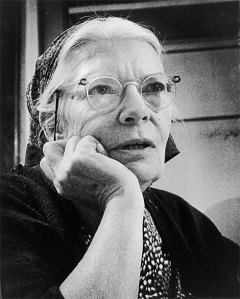
Dorothy Day
A few years ago I picked up a copy of The Long Loneliness, Dorothy Day’s autobiography. For those who don’t know of her, Day was a Catholic social activist and writer during the Great Depression and in the years afterwards. She and Peter Maurin were the guiding forces behind the Catholic Worker, a newspaper that described the mistreatment of the poor and advocated for social change to benefit them. I read the book earlier this summer, and wanted to say a few things about it.
I said that the book is an autobiography, but Day didn’t regard it as such. As she put it: “I have never intended to write an autobiography. I have always wanted instead to tell of things that brought me to God and that reminded me of God.” She saw her problems as simply a manifestation of what concerned all humanity, the “needs of sustenance and love.” The “long loneliness” of the title describes our inability to satisfy such needs fully. At times, the loneliness was severe, as when she moved to New York in 1916 at age 19: “In all that great city of seven millions, I found no friends; I had no work; I was separated from my fellows. Silence in the midst of city noises oppressed me. . . . I wanted to weep my loneliness away.” At times the loneliness almost lifted, as when a few years later she entered into a common-law marriage with Forester, an English anarchist, and lived in a beach house on Staten Island. She obviously delighted in the rich stew of people living at the beach, just as she later delighted in the myriad people who came through the hospitality houses sponsored by the Catholic Worker. She wrote of having been at peace during the years at the beach, but not having been entirely content:
“I was happy but my very happiness made me know that there was a greater happiness to be obtained from life than any I had ever known. I began to think, to weigh things, and it was at this time that I began consciously to pray more.”
Her spiritual movement culminated in her eventual conversion to Catholicism, to which Forester responded by leaving, just as Dorothy expected he would. She lamented, “I had known enough of love to know that a good healthy family life was as near to heaven as one could get in this life.” Dreading being alone, she had delayed her formal conversion. She only acted under the impetus of joy: the joy of having a daughter, combined with the desire to have the child baptized. We tend to think that unhappiness is a strong motivator for change, but often it only immobilizes. As with Day, joy rather than misery is often what propels us to take action.
Day initially felt dissonance over being a member of a church that sided with the powerful, hoarded wealth, and ignored social injustices. A few years later, though, she met Peter Maurin, a prophetic figure who had a vision of a transformed society in which workers could together produce enough so that everyone’s needs were met. Together, they founded the Catholic Worker movement, beginning with the newspaper but adding houses of hospitality and a number of farms. The book describes their struggles for just working conditions and fair wages, but Day’s primary interest appears to have been in people–those who were a part of the movement and those whom they helped. She was a pacifist in a time of nationalism and militarism; the fruitless struggle to change the country’s direction contributed to her loneliness.
Day was not an activist who shunned the contemplative life; she had a deep experience of God, and saw the primary purpose in life as growing in love for him. I was struck by her statement that this life is crucial for developing our relationship with God: “If we do not learn to enjoy God now we never will. If we do not learn to praise Him and thank Him and rejoice in Him now, we never will.” Even more than her relationship with God, though, sharing the journey with like-minded people was what sustained her. She put it this way:
“The only answer in this life, to the loneliness we are all bound to feel, is community. The living together, working together, sharing together, loving God and loving our brother, and living close to him in community so we can show our love for Him.”
Day reminds me of Christ’s parable of the treasure hidden in a field. Fnding a treasure, Day sold all she had—sold her happiness with Forester—to purchase that field. She knew when making the transaction the value that the Catholic faith would have for her, but didn’t realize until later that also located on the property would be the tremendous consolation of community. Her book gives no hint that she ever regretted the choice she made.
September 10, 2009 at 1:19 am
[…] Posted by bobritzema under community, loneliness Leave a Comment Recently I wrote a post on Dorothy Day’s quasi-autobiography The Long Loneliness. A few days later, I ran across this […]
August 28, 2011 at 3:37 pm
Great views on that!